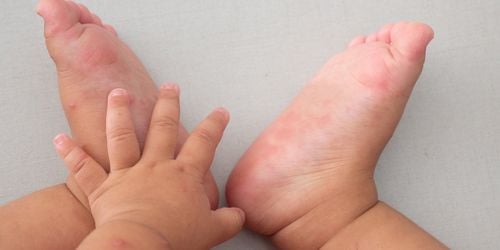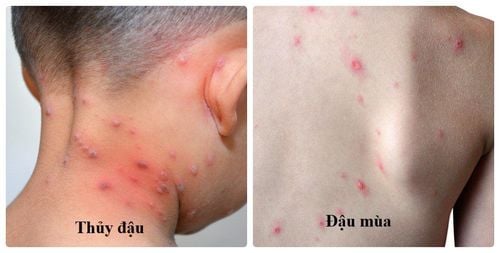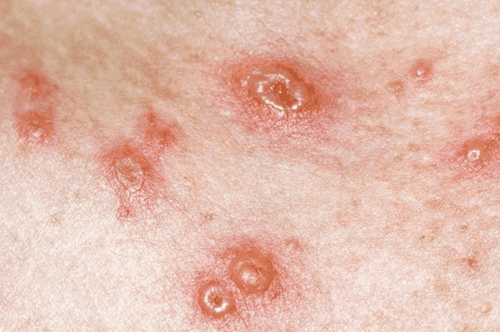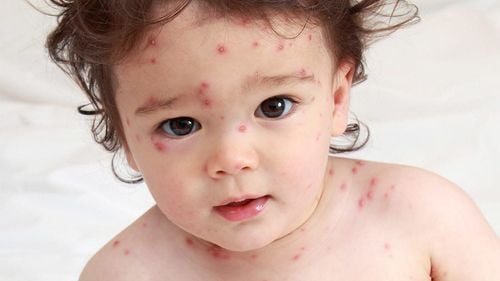Newborns often have uneven skin color or lack a rosy complexion due to various reasons, which can be either pathological or physiological. Therefore, parents need to care for and quickly recognize any abnormal signs on their baby's skin for timely treatment.
1. Issues with uneven skin color in newborns
Uneven skin color in newborns is very common. It usually takes more than 6 months to accurately determine the baby's skin color, whether it will be fair or dark. A lack of rosy skin is also common and can be influenced by factors such as race, age, body temperature, and even whether the baby is crying or not.
The most common issue related to uneven skin color in newborns is jaundice. This can be a normal or abnormal sign affecting the baby's health.
There are two types of jaundice:
- Physiological jaundice: Caused by the accumulation of bilirubin, a yellow pigment released when red blood cells break down. This condition is common in newborns due to their high red blood cell count, which is frequently broken down and replaced. The liver, not yet fully developed, cannot process bilirubin quickly enough, leading to jaundice. When the baby reaches 2 weeks old, the liver develops more fully and can handle bilirubin, so jaundice will naturally resolve.
- Pathological jaundice: This is a sign of an underlying disease, with the main symptom being jaundice along with other abnormal symptoms such as lethargy, poor feeding, and seizures. Pathological jaundice must be treated promptly to avoid complications like bilirubin-induced neurological toxicity, which can affect health.
To accurately determine whether the jaundice is physiological or pathological, it is necessary to visit a healthcare facility for examination. Additionally, jaundice in babies can also be caused by breast milk, but this is not a concern as it will resolve after 6 weeks to 3 months.

Other issues causing uneven skin color in newborns include:
Birthmarks: Uneven skin color can be due to congenital birthmarks. These can appear as moles in one area or spread across most of the body. These types of birthmarks cannot be improved and will remain on the child's skin unless addressed with cosmetic interventions as they grow older.
Redness leading to uneven skin color and lack of rosiness: Redness and heat rash can be caused by viruses or bacteria, such as roseola, scarlet fever, hand-foot-and-mouth disease, chickenpox, etc. Additionally, it can be due to allergies to pet hair, dust, detergents, bath products, or tight clothing.
Milk spots and seborrheic dermatitis (or cradle cap): These conditions can appear in the first months after birth and may last until the child is 2 years old. Uneven skin color due to milk spots or seborrheic dermatitis is normal and very common, so parents can rest assured and not worry too much.
2. Preventing neonatal jaundice
To prevent neonatal jaundice, parents should:
Maintain good mental and physical health during pregnancy, have regular prenatal check-ups to detect and treat any conditions early.
Ensure the baby's sleeping area has sufficient lighting to help keep the skin healthy and make it easier to observe any abnormalities.
Choose gentle skincare products for the baby, avoiding those with too many fragrances.
Dress the baby in loose, comfortable clothing and keep the surrounding area clean to avoid allergic reactions to dust.
Treat any viral or bacterial infections promptly to prevent skin damage and scarring.
Expose the baby to early morning sunlight to help synthesize vitamin D and keep the skin healthy.

3. Methods to treat pathological jaundice in babies
Sun exposure: Expose the baby to early morning sunlight, which is gentle and not harsh, to help synthesize vitamin D and keep the skin healthy.
Phototherapy is a common, simple, safe, and effective treatment method. The principle of phototherapy is to use light energy to penetrate the skin and convert free bilirubin in the blood into a non-toxic substance that is excreted in the stool and urine. The baby will be undressed, with the eyes and genital area covered during phototherapy, and turned periodically to increase the skin area exposed to light.
Blood exchange transfusion: This method is applied when phototherapy is ineffective or if there are accompanying neurological symptoms. Depending on different cases, the most appropriate method will be applied.
In summary, newborns often experience physiological phenomena during care, including issues with uneven skin color, lack of rosiness, and skin spots or rashes. Therefore, parents need to know how to recognize abnormal signs on their baby's skin for timely treatment.
To arrange an appointment, please call HOTLINE or make your reservation directly HERE. You may also download the MyVinmec app to schedule appointments faster and manage your reservations more conveniently.













